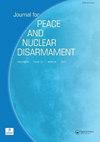中印巴核三难困境与意外战争
IF 1.4
Q4 INTERNATIONAL RELATIONS
引用次数: 0
摘要
本文的视角是中国-印度-巴基斯坦之间的地缘政治竞争,这构成了更广泛的全球核武器框架中嵌套的核三难困境的轮廓。在中印和印巴之间的核问题下,领土争端潜藏着潜在的冲突。这两对在结构上是分开的,但也连接在一起。形成核学说的信仰体系在中印两大阵营中具有共性。但在印巴两强关系中,情况并非如此。然而,人们在政治上认识到,在核威胁笼罩下,常规战争尚未开发的领域存在着危险。双方发生核战争的更大危险隐藏在无法控制冲突的升级中,这些冲突可能开始时规模不大,但可能会失控。本文运用克劳塞维茨升级模型来突出这一关键问题。因此,政策规定的方向是绝不测试核阈值的边界,并涉及降低警戒级别。提出了一项全球不首先使用核武器条约,只有在全球一级宣传核战争的危险,从而迫使政治领导人采取行动,这一条约才有可能实现。这是将领导人从各种不切实际的核战略的束缚中解放出来的必要步骤,这些战略无法回答第一枚核武器发射后会发生什么问题。本文章由计算机程序翻译,如有差异,请以英文原文为准。
The China–India–Pakistan Nuclear Trilemma and Accidental War
ABSTRACT The perspective of the paper is the geopolitical contestation between China–India–Pakistan, which frames the contours of the nuclear trilemma that is nested in the broader global nuclear weapons framework. Territorial disputes harbor the potential for conflict under the nuclear overhang between China–India and India–Pakistan. The two dyads are structurally separate but are also connected. Beliefs systems that shape nuclear doctrine have commonality in the China–India dyad. But such is not the case in the India-Pakistan dyad. There is, however, political recognition of the dangers that inhabit the unexplored space of conventional war under the nuclear over hang. The greater danger of nuclear war in both dyads is concealed in the inability to control escalation of conflicts that may have small beginnings but can potentially spin out of control. The paper uses Clausewitz escalation model to highlight this crucial issue. The policy prescriptions are therefore directed on never testing the boundaries of the nuclear threshold and relate to reduction of alert levels. A Global No First Use Treaty is proposed and one that is possible only if the dangers of nuclear war are publicized at the global level thus forcing the hand of political leaders. This is an imperative step to free the leadership from the shackles of varied impractical nuclear strategies that are unable to answer the question – what happens after the first nuclear weapon is fired.
求助全文
通过发布文献求助,成功后即可免费获取论文全文。
去求助
来源期刊

Journal for Peace and Nuclear Disarmament
INTERNATIONAL RELATIONS-
CiteScore
1.30
自引率
0.00%
发文量
36
审稿时长
12 weeks
 求助内容:
求助内容: 应助结果提醒方式:
应助结果提醒方式:


